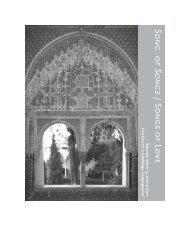BH1001, Guillaume Du Fay: Motets - Blue Heron
BH1001, Guillaume Du Fay: Motets - Blue Heron
BH1001, Guillaume Du Fay: Motets - Blue Heron
You also want an ePaper? Increase the reach of your titles
YUMPU automatically turns print PDFs into web optimized ePapers that Google loves.
hymn is sung in the middle voice, and the top<br />
voice sings in parallel fourths above it, thus<br />
producing by opposite means a sound identical to<br />
fauxbourdon; meanwhile the bass sings in thirds<br />
and fifths below. In Aurea luce we sing a verse<br />
in this sort of workaday improvised polyphony,<br />
conveying some idea of the unnotated sounds<br />
made by fifteenth-century choirs.<br />
Chansons and formes fixes<br />
The poetry and music of the secular songs on the<br />
program are cast in the formes fixes of medieval<br />
French poetry: rondeau, virelai, and ballade. The<br />
simplest of these is the ballade, usually three<br />
stanzas of the form aab. (Only one stanza for the<br />
haunting Je me complains is transmitted in its<br />
unique source, which is a great pity.) In musical<br />
settings of ballades the repeat of the a section is<br />
generally given an extended final melisma which<br />
returns to conclude the b section as well.<br />
The virelai, represented on this recording by<br />
Malheureulx cueur, takes the form AbbaA. (Capital<br />
letters indicate textual repeats; lower case, new<br />
text set to the same music.) Here the second b<br />
leads into a melismatic extension.<br />
The remaining chansons on this program are<br />
rondeaux, with the asymmetrical repeating<br />
form AB aA ab AB. The medievalist Christopher<br />
Page has written engagingly of the dynamic<br />
of rondeau form, in which an initial “proposal”<br />
(AB) is subjected to an “examination” through<br />
three repetitions of the first section of music (aA<br />
a) before the b section completes the refrain<br />
musically, but with new words. The rondeau<br />
finally culminates in a “confirmation” when the<br />
refrain is sung entire to its original words (AB). 4<br />
A poet might exploit the looping form of the<br />
rondeau to cast the A text, when repeated, in a<br />
new light: this is sometimes achieved by syntactical<br />
linking from verse to verse, as in J’atendray<br />
tant. The composer for his part is required by<br />
the form to craft an A section that will not pall<br />
on repeated hearing but rather reveal its inner<br />
qualities gradually, and a B section identified<br />
by something somehow new, so that it calls<br />
attention to itself upon first hearing the AB and<br />
creates a desire to hear it again—a desire whose<br />
gratification is delayed by the intervening aA a.<br />
The B section might be set apart by means as<br />
simple as introducing a moment of imitation, as<br />
Lantins does in Mon doulx espoir.<br />
<strong>Du</strong> <strong>Fay</strong> reveals his love of technical innovation<br />
and formal experimentation in the composition<br />
of chansons as much as any genre. He was fond<br />
of canons, and more than able to apply this<br />
strict procedure to a playful song. In Puisque<br />
vous estez campieur, the rivalry between the<br />
voices is underlined by the fact that they sing in<br />
canon at the octave, so that whatever the one<br />
does the other does, too, while the contratenor<br />
(here played on vielle) leaps and dashes about<br />
between them. Entre vous, gentils amoureux<br />
features a conversational canon at the fifth<br />
7



